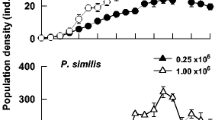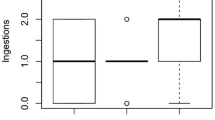Abstract
Loch Leven is a shallow, eutrophic lake in the Scottish lowlands that is famous for its brown trout (Salmo trutta L.) fishery. Studies of planktonic rotifer populations began here in January 1977. Since then, samples have been collected and analysed at more or less weekly intervals. Additional information on the composition and abundance of phytoplankton and crustacean zooplankton species, and on a variety of physical and chemical determinants, has been recorded on each sampling occasion.
Long-term datasets, such as that described above, are invaluable for identifying interactions between components of the plankton that only appear for short periods each year, as these interactions would probably be overlooked in data spanning a shorter period of time. This study uses the long-term data from Loch Leven to examine the food and temperature requirements of the summer rotifer species Trichocerca pusilla (Lauterborn). The results suggest that T. pusilla prefers water temperatures above 12 °C and that it feeds, primarily, on the filamentous diatom Aulacoseira spp. During the summer months, its abundance was closely related to the availability of this diatom. When filaments of Aulacoseira spp. were abundant, rotifer densities reached 1000–3000 ind. l−1 and when they were scarce (e.g. 1980, 1997 and 1998) T. pusilla densities also remained low (i.e. less than 100 ind. l−1). The reason for the success or failure of Aulacoseira during the summer months each year is unclear but, in general, its abundance was related to the availability of dissolved silica in the water.
Similar content being viewed by others
References
Bailey-Watts, A. E. & J. W. G. Lund, 1973. Observations on a diatom bloom in Loch Leven, Scotland. Biol. J. linn. Soc. 5: 235–253.
Bailey-Watts, A. E., 1976a. Planktonic diatoms and silica in Loch Leven, Scotland: a one month silica budget. Freshwat. Biol. 6: 203–213.
Bailey-Watts, A. E., 1976b. Planktonic diatoms and some diatomsilica relations in a shallow eutrophic Scottish loch. Freshwat. Biol. 6: 69–80.
De Beauchamp, P., 1909. Recherches sur les Rotifères: les formations tégumentaires at l'appareil digestif. Arch. Zool. exp. gJn. 10: 1–410.
Bērzinš, B. & B. Pejler, 1989. Rotifer occurrence in relation to temperature. Hydrobiologia 175: 223–231.
Carlin, B., 1943. Die Planktonrotatorien des Motalaström: zur taxonomie und Ökologie der Planktonrotatorien. Medd. Lunds Univ. limnol. Inst. 5: 1–255.
Golterman, H. L., R. S. Clymo & M. A. M. Olmstad, 1978. Methods for the Physical and Chemical Analysis of Freshwaters. 2nd edn. Publ. Blackwell, Oxford.
Jennings, H. S., 1903. Rotatoria of the United States. II. A monograph of the Rattulidae. Bull. U.S. Fish Comm.: 273–352.
Koste, W., 1976. Rotatoria: Die Rädertiere Mitteleuropas. Publ. Gebrhder Borntraeger, Berlin: 673 pp.
LLCMP (Loch Leven Catchment Management Project), 1999. The Loch Leven Catchment Management Plan: 93 pp.
Lund, J. W. G., 1949. Studies on Asterionella I. The origin and nature of the cells producing seasonal maxima. J. Ecol. 37: 389–419.
Lund, J. W. G., 1959. A simple counting chamber for nannoplankton. Limnol. Oceanogr. 4: 5–75.
Lund, J. W. G., 1962. Concerning a counting chamber for nannoplankton described previously. Limnol. Oceanogr. 7: 261–262.
May, L., 1980. Ecology of planktonic rotifers at Loch Leven, Kinross-shire. Ph.D Thesis, Paisley College of Technology: 180 pp.
May, L., 1983. Rotifer occurrence in relation to water temperature in Loch Leven, Scotland. Hydrobiologia 104: 311–315.
May, L., 1985. The use of procaine hydrochloride in the preparation of rotifer samples for counting. Verh. int. Ver. Limnol. 22: 2987–2990.
May, L., 1987. Effect of incubation temperature on the hatching of resting eggs collected from sediments. Hydrobiologia 147: 335–338.
Pourriot, R., 1970. Quelques Trichocerca (Rotifères) et leurs régime alimentaires. Ann. Hydrobiol. 1: 155–171.
Rutkowski, E. W., 1980. Studies on the feeding of Cyclops abyssorum Sars in Loch Leven, Kinross-shire, Scotland. MSc. Thesis, University of Stirling: 126 pp., 4 Appendices.
Ruttner-Kolisko, A., 1974. Plankton Rotifers: biology and Taxonomy. Die Binnengewässer, volume 26, supplement. Publ. Gebrüder Ranz, Dietenkeim: 146 pp.
Smith, I. R., 1974. The structure and physical environment of Loch Leven, Scotland. Proc. r. Soc. Edinb. (B) 74: 81–100.
Youngman, R. E., 1971. Algal monitoring of water supply reservoirs and rivers. Water Research Association TM63. The Water Research Association, Medmenham.
Author information
Authors and Affiliations
Rights and permissions
About this article
Cite this article
May, L., Bailey-Watts, A. & Kirika, A. The relationship between Trichocerca pusilla (Jennings), Aulacoseira spp. and water temperature in Loch Leven, Scotland, U.K.. Hydrobiologia 446, 29–34 (2001). https://doi.org/10.1023/A:1017508719110
Issue Date:
DOI: https://doi.org/10.1023/A:1017508719110




